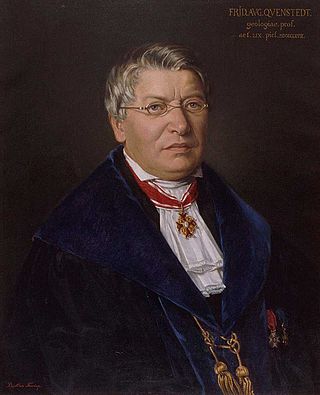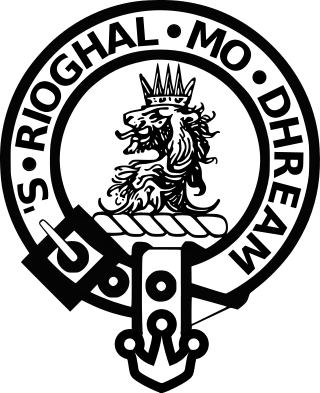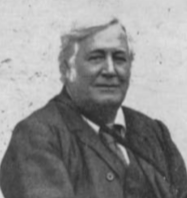

James Nicol FRSE FGS (12 August 1810 – 8 April 1879) was a Scottish geologist. [1]


James Nicol FRSE FGS (12 August 1810 – 8 April 1879) was a Scottish geologist. [1]
He was born at Traquair, near Innerleithen in Peeblesshire, the son of Rev. James Nicol (1769–1819), and his wife Agnes Walker. He studied Arts and Divinity at Edinburgh University from 1825. He also attended the lectures of Robert Jameson, having gained a keen interest in geology and mineralogy. He further pursued these studies in the universities of Bonn and Berlin. [2]
After returning home Nicol worked at local geology and obtained prizes from the Highland Society for essays on the geology of Peeblesshire and Roxburghshire, now areas of the Scottish Borders. He subsequently extended his researches over other parts of Scotland, and in 1844 published Guide to the Geology of Scotland. [2]
In 1847 Nicol was appointed assistant secretary to the Geological Society of London, [2] being appointed a Fellow of the Society in the same year. He was also elected a Fellow of the Royal Society of Edinburgh his proposer being George Wilson. [3]
In 1849 professor of geology in Queen's College, Cork, and in 1853 professor of natural history in the University of Aberdeen, a post which he retained until a few months before he died. [2] In his later years he lived at 15 Bon Accord Square in Aberdeen. [4]
He was buried with his wife and daughter in the north-west section of Grange Cemetery in Edinburgh.
In 1849 he married Alexandrina Anne Macleay Downie.
Nicol carried out researches on the Southern Uplands of Scotland and on the structure of the Highlands. In the former region he gave the first clear account of the succession of the fossiliferous Lower Palaeozoic rocks (1848–1852). When he came to deal with the still older Highland rocks he made out the position of the Torridonian sandstone and Durness limestone, and their relations to the schists and gneisses. [2] Nichol's mature views, although recognising the fallacy in the extant theory of Roderick Murchison, were subsequently superseded by the theory of Charles Lapworth which was corroborated by Benjamin Peach and John Horne. Nicol [5] criticised Thomas Jamieson's explanation of the Parallel Roads of Glen Roy. Jamieson [6] considered that the features were shorelines of a fresh water lake trapped behind a glacier; Nicol maintained that the 'overflow cols' show no indications of a water torrent; he concluded that they were sea-straits and therefore the 'roads' were of marine origin.
The more important of his papers were:
He contributed the article "Mineralogy" to the ninth edition of the Encyclopædia Britannica . Among his other works were:

The Highlands is a historical region of Scotland. Culturally, the Highlands and the Lowlands diverged from the Late Middle Ages into the modern period, when Lowland Scots language replaced Scottish Gaelic throughout most of the Lowlands. The term is also used for the area north and west of the Highland Boundary Fault, although the exact boundaries are not clearly defined, particularly to the east. The Great Glen divides the Grampian Mountains to the southeast from the Northwest Highlands. The Scottish Gaelic name of A' Ghàidhealtachd literally means "the place of the Gaels" and traditionally, from a Gaelic-speaking point of view, includes both the Western Isles and the Highlands.

Friedrich August von Quenstedt was a German geologist and palaeontologist.

Sir Richard John Griffith Bt. FRS FRSE FGS LLD, was an Irish geologist, mining engineer and chairman of the Board of Works of Ireland, who completed the first complete geological map of Ireland and was the author of the valuation of Ireland; subsequently known as Griffith's Valuation.
Professor Robert Harkness FRS FRSE FGS, was a British geologist and mineralogist.

James Murdoch Geikie PRSE FRS LLD was a Scottish geologist. He was professor of geology at Edinburgh University from 1882 to 1914.
David Forbes FRS was a Manx mineralogist, metallurgist, and chemist.

Clan Gregor, also known as Clan MacGregor, is a Highland Scottish clan that claims an origin in the early 9th century. The clan's most famous member is Rob Roy MacGregor of the late 17th and early 18th centuries. The Clan is also known to have been among the first families of Scotland to begin playing the bagpipes in the early 17th century.

Benjamin Neeve Peach was a British geologist.

Clement Reid FRS was a British geologist and palaeobotanist.

Glen Roy in the Lochaber area of the Highlands of Scotland is a glen noted for the geological phenomenon of three loch terraces known as the Parallel Roads of Glen Roy. The terraces formed along the shorelines of an ancient ice-dammed loch that existed during a brief period of climatic deterioration, during a much longer period of deglaciation, subsequent to the last main ice age. From a distance they resemble man-made roads running along the side of the glen, hence the name. Much of the glen is designated as a national nature reserve.
Joseph Jackson Lister FRS was a British zoologist and plant collector from Leytonstone who collected biological specimens during travels in Africa, Asia, Australasia and the Pacific region.

Edmund Johnston Garwood was a British geologist and President of the Geological Society of London from 1930 to 1932.

Dr James Murray FRSE was a biologist and explorer.

Philip Herbert Carpenter, FRS, British naturalist and crinoid authority, was the fourth son of William Benjamin Carpenter.

John Scouler was a Scottish naturalist.

Bernard Elgey Leake is an English geologist. He is Emeritus Professor of Geology at the University of Glasgow, was Leverhulme Emeritus Fellow at Cardiff University 2000-2002 and has been an Honorary Research Fellow at Cardiff University since 1997.

Sir George Steuart Mackenzie, 7th Baronet FRS FRSE FSA was a Scottish geologist, chemist and agricultural improver.

George Auldjo Jamieson FRSE was a Scottish businessman, chartered accountant and local councillor.

The Highlands controversy was a scientific controversy which started between British geologists in the middle of the nineteenth century concerning the nature of the rock strata in the Northwest Highlands of Scotland. The debate became contentious, even acrimonious, because of some of the personalities involved and because it pitted professional geologists of the Geological Survey against academic and amateur geologists. An initial resolution was achieved by about 1886 but the great complexity and scientific importance of the discovery of the Moine Thrust Belt and the geological processes involved in its creation led to field work continuing for a further twenty years culminating in the 1907 publication by the Geological Survey of a book of fundamental geological significance: The Geological Structure of the North-West Highlands of Scotland.
Thomas McLauchlan (1815–1886) was a Scottish minister and theological author who served as Moderator of the General Assembly for the Free Church of Scotland 1876/77.